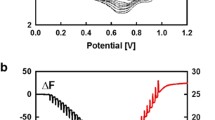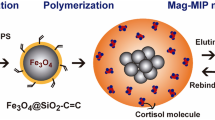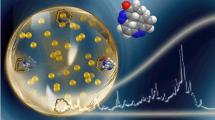Abstract
A label-free molecular imprinted polymer (MIP) sensor was fabricated for the detection of progesterone in aqueous solutions, by polymerization inside the void spaces of colloidal crystals, which gave them photonic properties. The prepolymerization mixture was prepared from acrylic acid as the functional monomer, ethylene glycol as the cross-linker agent, ethanol as solvent, and progesterone as the imprinted template. After polymerization, the colloidal crystal was removed by acid etching and the target eluted with a solvent. Material characterization included as follows: attenuated total reflectance-Fourier-transform infrared spectroscopy, dynamic light scattering, swelling experiments, and environmental scanning electron microscopy. MIPs were investigated by equilibrium binding, kinetics experiments, and UV–visible spectra to investigate Bragg diffraction peak shift that occurs with the rebinding at different progesterone concentrations in deionized water and 150-mM NaCl solutions. The MIP response was investigated with progesterone concentration in the 1–100 μg L−1 range, with LOD of 0.5 μg L−1, reaching the detected range of hormone in natural waters. Furthermore, hydrogel MIP films were successfully tested in various real water matrices with satisfactory results. Moreover, the MIP film exhibited good selectivity toward the progesterone hormone evidenced by a larger response than when exposed to structurally similar molecules. Computational studies suggested that size along with surface potential influenced the binding of analog compounds. Due to their ease of use and low cost, the sensors are promising as screening tools for the presence of progesterone in aqueous samples.
Graphical abstract








Similar content being viewed by others
References
Ričanyová J, Gadzała-Kopciuch R, Reiffova K, Bazel Y, Buszewski B (2010) Molecularly imprinted adsorbents for preconcentration and isolation of progesterone and testosterone by solid phase extraction combined with HPLC. Adsorption 16(4):473–483. https://doi.org/10.1007/s10450-010-9265-7
Fent K (2015) Progestins as endocrine disrupters in aquatic ecosystems: concentrations, effects and risk assessment. Environ Int 84:115–130. https://doi.org/10.1016/j.envint.2015.06.012
Golovko O, Šauer P, Fedorova G, Kroupová HK, Grabic R (2018) Determination of progestogens in surface and waste water using SPE extraction and LC-APCI/APPI-HRPS. Sci Total Environ 621:1066–1073. https://doi.org/10.1016/j.scitotenv.2017.10.120
Kumar V, Johnson AC, Trubiroha A, Tumová J, Ihara M, Grabic R, … Kroupová HK (2015) The challenge presented by progestins in ecotoxicological research: a critical review. Environ Sci Technol 49(5), 2625–2638https://doi.org/10.1021/es5051343
Kasambala HR, Rwiza MJ, Mdegela RH (2019) Levels and distribution of progesterone in receiving waters and wastewaters of a growing urban area. Water Sci Technol 80(6):1107–1117. https://doi.org/10.2166/wst.2019.350
Huang X, Yuan D, Huang B (2008) Determination of steroid sex hormones in urine matrix by stir bar sorptive extraction based on monolithic material and liquid chromatography with diode array detection. Talanta 75(1):172–177. https://doi.org/10.1016/j.talanta.2007.10.052
Tomšíková H, Aufartová J, Solich P, Nováková L, Sosa-Ferrera Z, Santana-Rodríguez JJ (2012) High-sensitivity analysis of female-steroid hormones in environmental samples. TrAC, Trends Anal Chem 34:35–58. https://doi.org/10.1016/j.trac.2011.11.008
Chang H, Wan Y, Wu S, Fan Z, Hu J (2011) Occurrence of androgens and progestogens in wastewater treatment plants and receiving river waters: comparison to estrogens. Water Res 45(2):732–740. https://doi.org/10.1016/j.watres.2010.08.046
Alvarez-Lorenzo C (2013) Handbook of molecularly imprinted polymers. Smithers Rapra
Cáceres C, Bravo C, Rivas B, Moczko E, Sáez P, García Y, Pereira E (2018) Molecularly imprinted polymers for the selective extraction of bisphenol A and progesterone from aqueous media. Polymers, 10(6). https://doi.org/10.3390/polym10060679
Arabi M, Ostovan A, Bagheri AR, Guo X, Wang L, Li J, … Chen L (2020) Strategies of molecular imprinting-based solid-phase extraction prior to chromatographic analysis. TrAC Trends Anal Chem 128, 115923https://doi.org/10.1016/j.trac.2020.115923
Arabi M, Ostovan A, Bagheri AR, Guo X, Li J, Ma J, Chen L (2020) Hydrophilic molecularly imprinted nanospheres for the extraction of rhodamine B followed by HPLC analysis: a green approach and hazardous waste elimination. Talanta 215:120933. https://doi.org/10.1016/j.talanta.2020.120933
Gholami H, Ghaedi M, Ostovan A, Arabi M, Bagheri AR (2019) Preparation of hollow porous molecularly imprinted and aluminum(III) doped silica nanospheres for extraction of the drugs valsartan and losartan prior to their quantitation by HPLC. Mikrochim Acta 186(11):702. https://doi.org/10.1007/s00604-019-3794-x
Casis N, Busatto C, Fidalgo de Cortalezzi MM, Ravaine S, Estenoz DA (2015) Molecularly imprinted hydrogels from colloidal crystals for the detection of progesterone. Polym Int 64(6):773–779. https://doi.org/10.1002/pi.4851
Lin Z, Li L, Fu G, Lai Z, Peng A, Huang Z (2020) Molecularly imprinted polymer-based photonic crystal sensor array for the discrimination of sulfonamides. Anal Chim Acta 1101:32–40. https://doi.org/10.1016/j.aca.2019.12.032
Han S, Jin Y, Su L, Chu H, Zhang W (2020) A two-dimensional molecularly imprinted photonic crystal sensor for highly efficient tetracycline detection. Anal Methods 12(10):1374–1379. https://doi.org/10.1039/D0AY00110D
Kadhem AJ, Xiang S, Nagel S, Lin C-H, Fidalgo de Cortalezzi M (2018) Photonic molecularly imprinted polymer film for the detection of testosterone in aqueous samples. Polymers 10(4):349. https://doi.org/10.3390/polym10040349
Dai J, Fidalgo de Cortalezzi M (2019) Influence of pH, ionic strength and natural organic matter concentration on a MIP-fluorescent sensor for the quantification of DNT in water. Heliyon 5(6):e01922. https://doi.org/10.1016/j.heliyon.2019.e01922
Krishnakumar V, Balachandran V (2005) Analysis of vibrational spectra of 5-fluoro, 5-chloro and 5-bromo-cytosines based on density functional theory calculations. Spectrochim Acta Part A Mol Biomol Spectrosc 61(5):1001–1006. https://doi.org/10.1016/j.saa.2004.05.044
Azofra LM, Alkorta I, Elguero J (2013) Theoretical study of the mutarotation of erythrose and threose: acid catalysis. Carbohyd Res 372:1–8. https://doi.org/10.1016/j.carres.2013.01.013
Lin H, Wu D, Liu L, Jia D (2008) Theoretical study on molecular structures, intramolecular proton transfer reaction, and solvent effects of 1-phenyl-3-methyl-4-(6-hydro-4-amino-5-sulfo-2,3-pyrazine)-pyrazole-5-one. J Mol Struct (Thoechem) 850(1):32–37. https://doi.org/10.1016/j.theochem.2007.10.011
Kolar P, Classen J, Hall SG (2019) Physicochemical data of p-cresol, butyric acid, and ammonia. Data Brief 26:104356. https://doi.org/10.1016/j.dib.2019.104356
Zhang J, Lu T (2021) Efficient evaluation of electrostatic potential with computerized optimized code. Phys Chem Chem Phys 23(36):20323–20328. https://doi.org/10.1039/D1CP02805G
Jiang P, Bertone JF, Hwang KS, Colvin VL (1999) Single-crystal colloidal multilayers of controlled thickness. Chem Mater 11(8):2132–2140. https://doi.org/10.1021/cm990080+
Chen S, Sun H, Huang Z, Jin Z, Fang S, He J, … Lai J (2019) The visual detection of anesthetics in fish based on an inverse opal photonic crystal sensor. RSC Advances, 9(29), 16831–16838https://doi.org/10.1039/C9RA01600G
Zhou C, Wang T, Liu J, Guo C, Peng Y, Bai J, … Gao Z (2012) Molecularly imprinted photonic polymer as an optical sensor to detect chloramphenicol. The Analyst, 137(19), 4469https://doi.org/10.1039/c2an35617a
Kadhem AJ, Gentile GJ, Fidalgo de Cortalezzi MM (2021) Molecularly imprinted polymers (MIPs) in sensors for environmental and biomedical applications: a review. Molecules (Basel, Switzerland) 26(20):6233. https://doi.org/10.3390/molecules26206233
Nawaz T, Ahmad M, Yu J, Wang S, Wei T (2020) The biomimetic detection of progesterone by novel bifunctional group monomer based molecularly imprinted polymers prepared in UV light. New J Chem 44(17):6992–7000. https://doi.org/10.1039/C9NJ06387K
Nezhadali A, Es’haghi Z, Khatibi A (2016) Selective extraction of progesterone hormones from environmental and biological samples using a polypyrrole molecularly imprinted polymer and determination by gas chromatography. Analytical Methods 8(8):1813–1827. https://doi.org/10.1039/C5AY02174J11.11.008
Chen W, Meng Z, Xue M, Shea K (2016) Molecular imprinted photonic crystal for sensing of biomolecules. Molecular Imprinting 4:1–12. https://doi.org/10.1515/molim-2016-0001
Kibechu RW, Mamo MA, Msagati TAM, Sampath S, Mamba BB (2014) Synthesis and application of reduced graphene oxide and molecularly imprinted polymers composite in chemo sensor for trichloroacetic acid detection in aqueous solution. Physics and Chemistry of the Earth, Parts A/B/C 76–78:49–53. https://doi.org/10.1016/j.pce.2014.09.008
Huang J, Hu X, Zhang W, Zhang Y, Li G (2008) pH and ionic strength responsive photonic polymers fabricated by using colloidal crystal templating. Colloid Polym Sci 286(1):113–118. https://doi.org/10.1007/s00396-007-1775-9
Kempe H, Kempe M (2010) Influence of salt ions on binding to molecularly imprinted polymers. Anal Bioanal Chem 396(4):1599–1606. https://doi.org/10.1007/s00216-009-3329-0
Boufas W, Dupont N, Berredjem M, Berrezag K, Becheker I, Berredjem H, Aouf N-E (2014) Synthesis and antibacterial activity of sulfonamides. SAR and DFT studies. J Mol Struct 1074:180–185. https://doi.org/10.1016/j.molstruc.2014.05.066
Author information
Authors and Affiliations
Corresponding author
Ethics declarations
Conflict of interest
The authors declare no competing interests.
Additional information
Publisher’s note
Springer Nature remains neutral with regard to jurisdictional claims in published maps and institutional affiliations.
Supplementary Information
Below is the link to the electronic supplementary material.
Rights and permissions
About this article
Cite this article
Qasim, S., Hsu, SY., Rossi, E. et al. Detection of progesterone in aqueous samples by molecularly imprinted photonic polymers. Microchim Acta 189, 174 (2022). https://doi.org/10.1007/s00604-022-05290-w
Received:
Accepted:
Published:
DOI: https://doi.org/10.1007/s00604-022-05290-w




